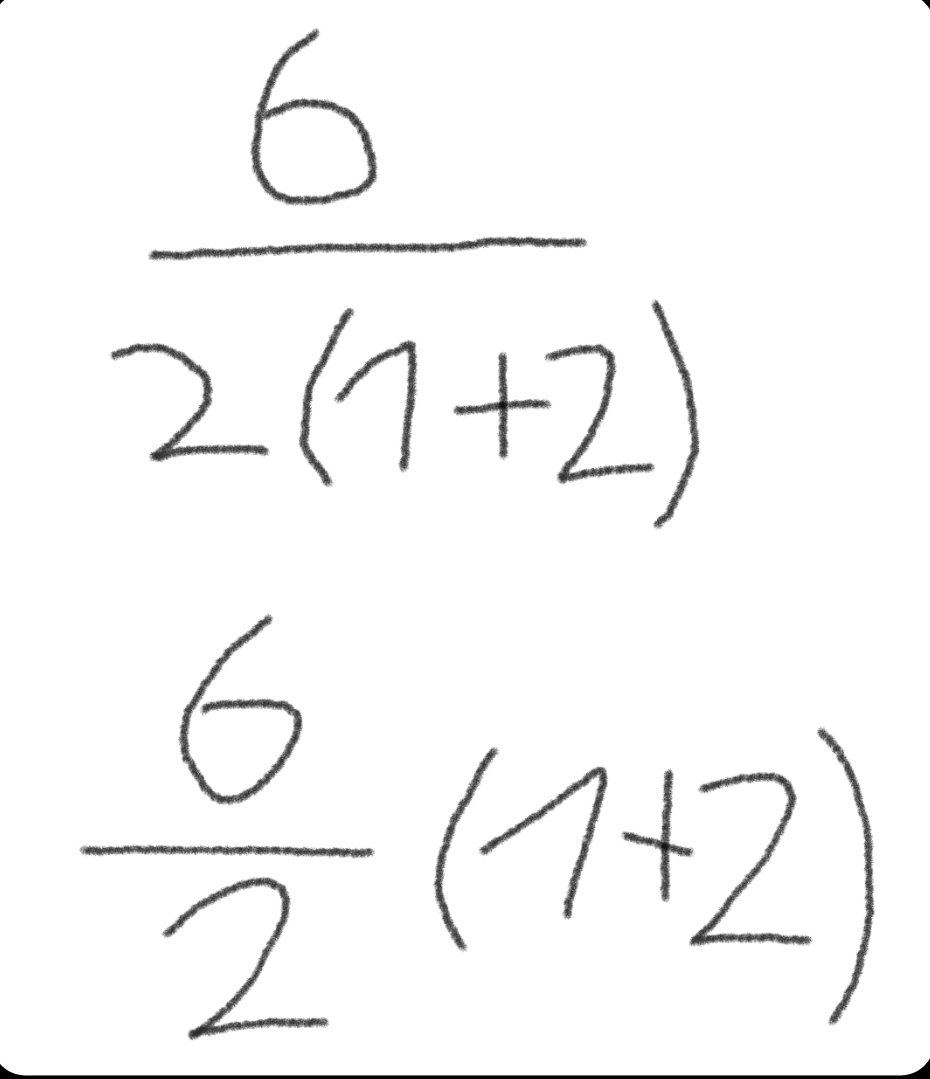this post was submitted on 28 Oct 2024
27 points (100.0% liked)
chapotraphouse
13646 readers
1021 users here now
Banned? DM Wmill to appeal.
No anti-nautilism posts. See: Eco-fascism Primer
Slop posts go in c/slop. Don't post low-hanging fruit here.
founded 4 years ago
MODERATORS
you are viewing a single comment's thread
view the rest of the comments
view the rest of the comments

Assuming the first way is written correctly, the equation is actually 6 / (2 * (1 + 2)). The (1 + 2) is still inside the denominator. So it is solved as follows:
6 / (2 * (1 + 2))
6 / (2 * 3)
6 / 6
1
The second equation incorrectly takes out the (1 + 2) and places it as the numerator on the side. In order to take that piece out correctly, it would have to be: (6 / 2) * (1 / (1 + 2))
And to solve it, it would look like as follows:
(6 / 2) * (1 / (1 + 2))
3 * (1 / (1 + 2))
3 * (1 / 3)
3 / 3
1
Also, 3 * 3 = 9 in regards to second incorrect equation (incorrect meaning the second incorrectly refactored equation from the pic that you answered correctly up until the last operation).
I think The_sleepy_woke_dialectic forgot to put parentheses around the denominator, but I believe it was meant to be interpreted as the entire denominator as shown in the pic.
My bad on typing 6 as the final number, typo.
I think the image is discussing the two ways most people interpret the (deliberately slightly obtuse) equation 6 / 2(1+2) Following BEDMAS BOMDAS PEMDAS or however you call it in your area as written, the correct interpretation is interpretation #2, which resolves to 9,
However many people also interpret the implitic multiplication in 2(1+2) to have higher priority, or makes the 2 and () into one unit, as if put into Parentheses, which leads to interpretation #1, which resolves to 1.
The real answer is to make the original question less obtuse, but any parsing algorithm correctly given the rules of mathematical notation would resolve it to 9
I just realized where the confusion is coming from:
A fraction written in the formation as shown in the image has implicit parentheses over the numerator and the denominator (as well as the entire fraction) that need to be explicitly written when converted to single-line form.
The rest of my response is just for extra clarification
If we assume the second equation is true, then the first would have to be represented as (6 * (1 + 2)) / 2, which is (6 * 3) / 2, which is 18 / 2, which is 9. This means the mistake was made by multiplying the fraction with (1 + 2) by incorrectly placing it in the denominator instead of the numerator. I think the image is supposed to be a tongue-in-cheek troll as the two equations are non-preserving transformations of each other. It's a common mistake that is made in arithmetic.Here are the equations in WolframAlpha:
https://www.wolframalpha.com/input?i2d=true&i=Divide%5B6%2C2%5C%2840%291%2B2%5C%2841%29%5D
https://www.wolframalpha.com/input?i2d=true&i=Divide%5B6%2C2%5D%5C%2840%291%2B2%5C%2841%29
Unfortunately the step by step solutions are now locked behind a subscription.
Both problems are valid on their own. There's no correct interpretation. If we want to assume they were supposed to be equal to each other, this means one was incorrectly transformed from the other due to common mistakes that occur with two-dimensional fractions. The horizontal line between a fraction is not equal to / without implicit parentheses applied, otherwise the horizontal line would only apply to the first number, which is not the point of a two-dimensional fraction.